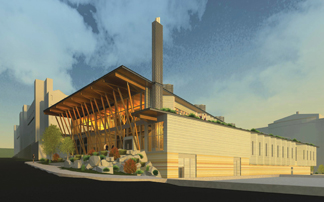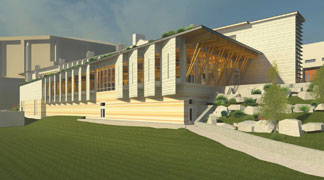N.Y. College Targets Platinum

SYRACUSE, N.Y. — It should come as no surprise that the new Gateway Building, presently under construction at the State University of New York, has been designed to meet LEED Platinum certification and will showcase a sophisticated array of renewable energy technologies. After all, the $28.3 million building is part of the university’s College of Environmental Science and Forestry.
But, according to officials, the building, with 50,000 square feet of useable space, will be even more efficient than similar buildings of its type and size.
“The Gateway Building’s design and construction sets a new standard for LEED buildings, producing more renewable energy than it consumes,” says the environmental college’s president, Cornelius B. Murphy, Jr. “The building has a state-of-the-art bioclimatic shell while using solar, biodiesel and biomass resources to provide most of its energy requirements.”
Housing a conference center with seating for up to 500 people, as well as a new bookstore, cafeteria, and an exhibition gallery displaying the college’s Roosevelt Wild Life Station, the Gateway Building will contain facilities and programs never before offered on the College of ESF campus.

The Gateway Building will feature a unique design with a main entrance, a top floor, and a bottom floor. On the top floor will be a vegetative roof, featuring native plants and a walkout observation deck. Roof-mounted photovoltaics and solar thermal systems will provide both electricity and hot water.
The bottom floor will include a combined heat and power system designed to produce steam heat and electric power for the Gateway Building and four other academic structures, meeting up to 65 percent of the campus’ heating needs and 20 percent of its electrical load. The CHP system will use a wood pellet-fueled boiler connected to a steam turbine to product heat and electricity during the coldest months of the year.
A second CHP system, powered by three micro turbines fueled with natural gas and biodiesel, will produce additional heat and electricity year-round. As a result, the Gateway Building is projected to consume about 75 percent less than some of the campus’ older buildings.
Other green elements include natural ventilation, radiant heating in the floors, an environmental monitoring system, and rain gardens that facilitate storm water runoff.
